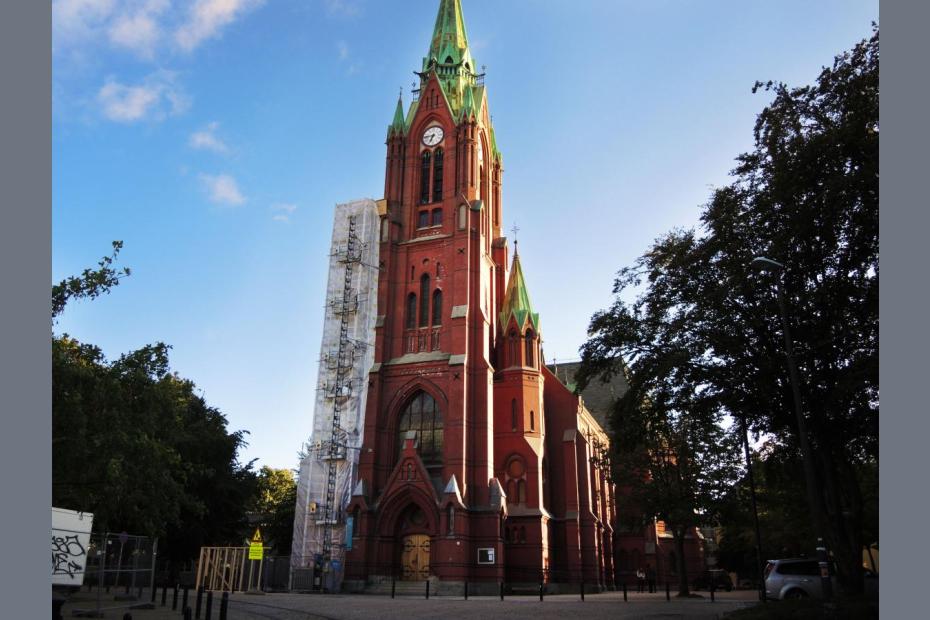Christian feasts still constitute most of the official holidays in Norway, which marks as national holidays Palm Sunday, Holy Thursday through Easter Monday; Ascension Thursday, Pentecost (Whit Sunday and Whit Monday), Christmas Day and Boxing Day. Carnival, though not Ash Wednesday; St. John’s Day, which coincides with summer solstice; and Halloween are also commonly observed there, though not as legal holidays. Norwegian Catholic interviewees report that the feasts themselves have largely just become occasions for holidays. Christmas still has food and other traditions tied to it, and is a time when churches are full. Easter is a time when schools and businesses close up in the cities, and Norwegians retreat for the long holiday to rural cabins.
Christmas
“Christmas season,” as most described it, starts on Dec. 1 and coincides with Advent. Secular-themed Christmas TV shows run for 24 days. Christmas trees start to appear in public squares. Some homes hang a sort of advent calendar, with 24 pockets of small gifts and candy for children to open each day as they count down. Santa Lucia day, Dec. 13, is celebrated in public schools, featuring a procession, white dresses for the girls, lights and candle crowns, but it has no explicitly religious connection. People bake Christmas cookies and cakes, and set up and decorate their own tree right before Christmas. Dec. 24, Christmas Eve, is the time for the family dinner, and the time when presents, some from Julenissen — or Santa — are opened. Christmas itself is a quiet day. People who usually don’t go to church tend to go on Christmas Eve, or perhaps on Christmas Day. Christmas meal traditionally includes Pinnekjøtt, a dried lamb dish, or a special pork dish, special sausages and winter vegetables.
Easter
Easter is a time to retreat to mountains or fjords, including for Catholics, since it is a major vacation time. As one interviewee put it, in Norwegian society, “no one thinks about what Easter means.” Several interviewees said that an Easter meal could be anything good that one wanted, and a few suggested that lamb was ideal, or eggs, but everyone associated Easter with chocolate and other candy. Lent is not a part of Norwegian culture. One Catholic interviewee said his work colleagues were “dumbfounded” at his fasting and abstinence.
Corpus Christi: Standing out in the streets
Catholics in Bergen, a large and ethnically diverse community, were more likely to point out several feasts that made them stand out from their Church of Norway counterparts. The parish celebrates the feast of its patron, St. Paul, on Jan. 25 with Mass and a common meal celebration featuring Vietnamese and Tamil food. The Vietnamese community also celebrates the feast of the Vietnamese Martyrs, and other ethnic groups sometimes meet for smaller celebrations related to their cultures.
The feast that was most mentioned, perhaps because it makes them stand out culturally and brings a great many of them together, is Corpus Christi, the June procession in honor of the Eucharist. It used to be held just at the church, but over time has spread out into the streets. The procession in 2015 began at St. Paul’s church and traveled along a route through the museum area, along the lake at the center of Bergen, and up the hill to St. John’s church, a very large Church of Norway church on the hill above St. Paul’s, where they celebrated Mass in Norwegian. Along the way, the procession stopped at each of several altars representing some of the major ethnic groups of the parish. Some people in the parish — particularly the Vietnamese, but also a few Norwegians, dressed in traditional costumes.
People in the streets are said to have reacted with surprise, and see it as strange, but also stopped to ask questions. One participant concluded, “Corpus Christi is a way of asserting that Catholics belong here as much as anyone and are a part of Norwegian society. We are allowed to show that we are believers, and we have a right to show that and be heard.” A multicultural society and the increased number of Catholics, he said, make it easy for them to say that they have a public place in this society.
Food and the diversity of ethnic foods were a significant part of the celebration afterward, and each group brought some of its own food.
The presence of national costumes and the move into the streets bore similarities to May’s Constitution Day, a major Norwegian holiday when people often dress in traditional Norwegian costumes and go out to parade in the street. Much as the Corpus Christi procession seemed like a Catholic parallel in a country where Catholics have long had to prove they belong, the St. Paul’s parishioners never saw a connection between the two events.













